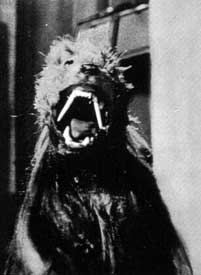The Killer Shrews

A 1959 monster movie starring James "Roscoe P" Best.
Thorne Sherman is the captain of a small supply boat sent to bring provisions to a lab on an isolated island. When he arrives, inclement weather prevents the offloading of provisions, and he finds the resident scientists nervously awaiting him with guns. Much Natter and beating around the bush ensues, until finally the truth comes out: The scientists have been performing experiments on overpopulation by genetically engineering shrews which grow to the size of sheep dogs, eat incessantly and breed profusely. These giant shrews have escaped and are overrunning the island, stripping it of food until the monsters must turn on the humans, trapping them in the small house/lab.
Unfortunately for the humans, the rains are weakening the house's adobe walls, allowing the Killer Shrews to burrow their way in. Although only a couple shrews actually make it inside, it's enough to kill a house servant and a lab researcher; the shrews also gobble up Thorne's sidekick Rook whilst attempting to bring items ashore from the boat (not that anyone notices the demise of the black guy). Realizing they can't stay in the house because the shrews are getting in, but can't go out of the house because the shrews are out there, Thorne gets creative and builds a portable tank out of empty oil drums. He, his Love Interest and her father the lead scientist all escape to the beach in this tank and finally ditch into the ocean and swim out to Thorne's boat (now safe, since shrews can't swim); but the last lab assistant panics and refuses to join them in their escape, and so gets hisself et. The shrews are left trapped on the island, where it is assumed they will eventually starve and die off.
For the Mystery Science Theater 3000 episode see here.
- Artistic License Gun Safety: When the Mexican servant is bitten in the leg by a shrew, Thorne tries to stop the bleeding with a tourniquet. What does he use to tighten it? The barrel of his loaded revolver.
- Attack Of The 5 Foot Whatever: Although the Killer Shrews are easily much much much larger than they should be, this still makes them only about the size of an average dog. What really makes them dangerous is their poisonous saliva.
- Black Dude Dies First, and Mexican dude dies second.
- Closed Circle: The island. An imminent hurricane prevents a quick evacuation.
- Dirty Coward: Lab assistant Jerry.
- Did Not Do the Research: The other wiki claims that shrews are at least good enough swimmers to hunt in water.
- Ironically enough, they throw out the fact that the shrew has a poisonous bite; instead, they say the venom comes from poisons they've set out as bait that they've adapted into their systems. Honestly, being naturally venomous is a more rational explanation.
- Possibly Science Marches On, as the question of whether shrews actively secrete their own venom or recycle it from the tissues of toxic insects may not yet have been resolved when the film was made.
- Ironically enough, they throw out the fact that the shrew has a poisonous bite; instead, they say the venom comes from poisons they've set out as bait that they've adapted into their systems. Honestly, being naturally venomous is a more rational explanation.
- For Science!: The creation of the Killer Shrews was actually an experiment to study the effects of overpopulation, an experiment which has (everybody say it with me) Gone Horribly Right.
- Also, one of the scientists, when fatally bitten by a shrew, calmly records the progression of symptoms right up to the instant of his death, rather than say anything to all the people in the room with him.
- Jerkass: Jerry.
- Karmic Death: Jerry, after repeatedly trying to feed the hero to the shrews, finally is taken down by them himself.
- MacGyvering
- Mad Scientist's Beautiful Daughter
- Plucky Comic Relief: Rook, the hero's plucky sidekick (see also Black Dude Dies First)
- Rodents of Unusual Size: Shrews are members of order Rodentia, after all.
- Scare Chord
Sherman: How big do [the shrews] get?
[chord]
- Slurpasaur: The eponymous shrews are played by dogs in very unconvincing masks.